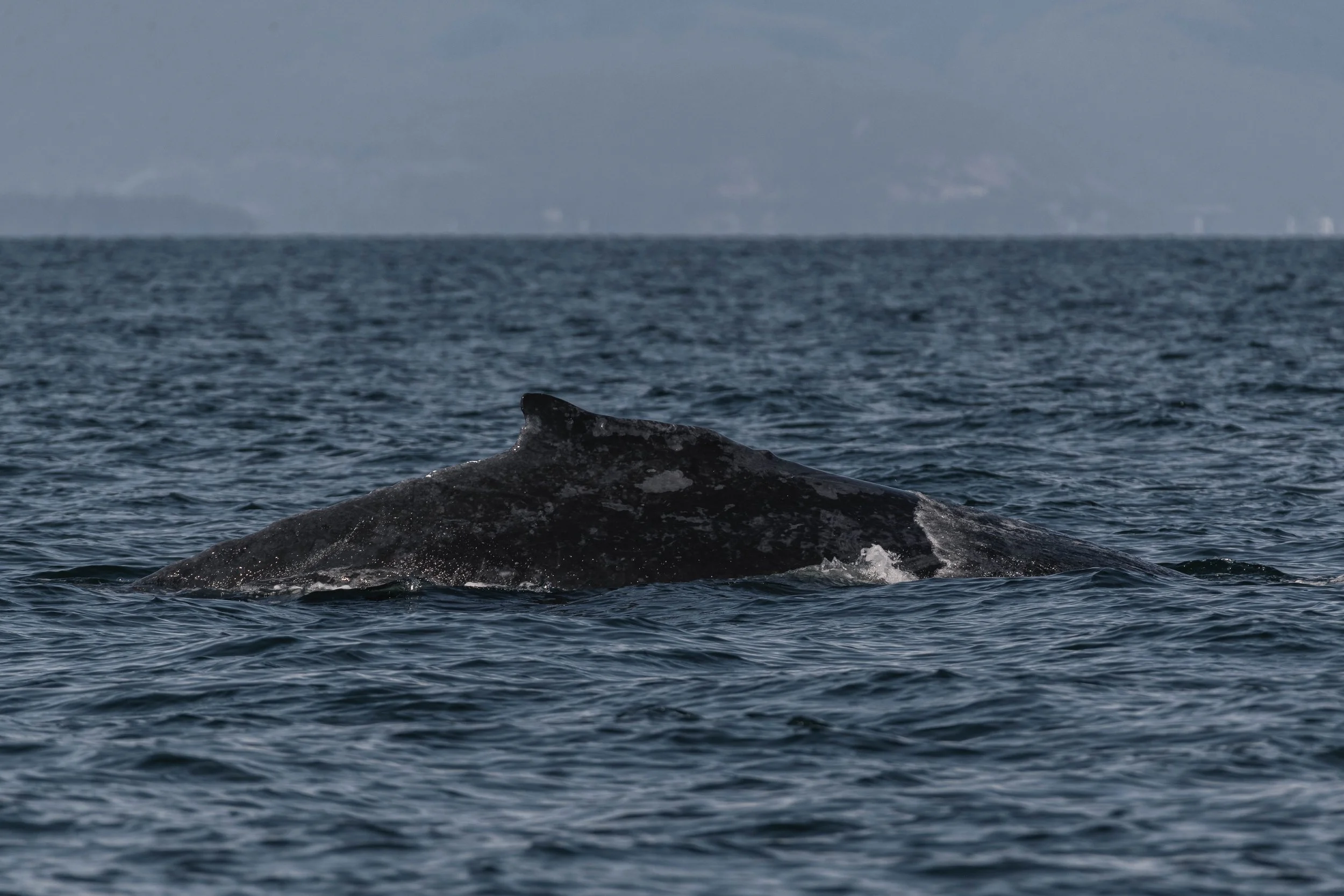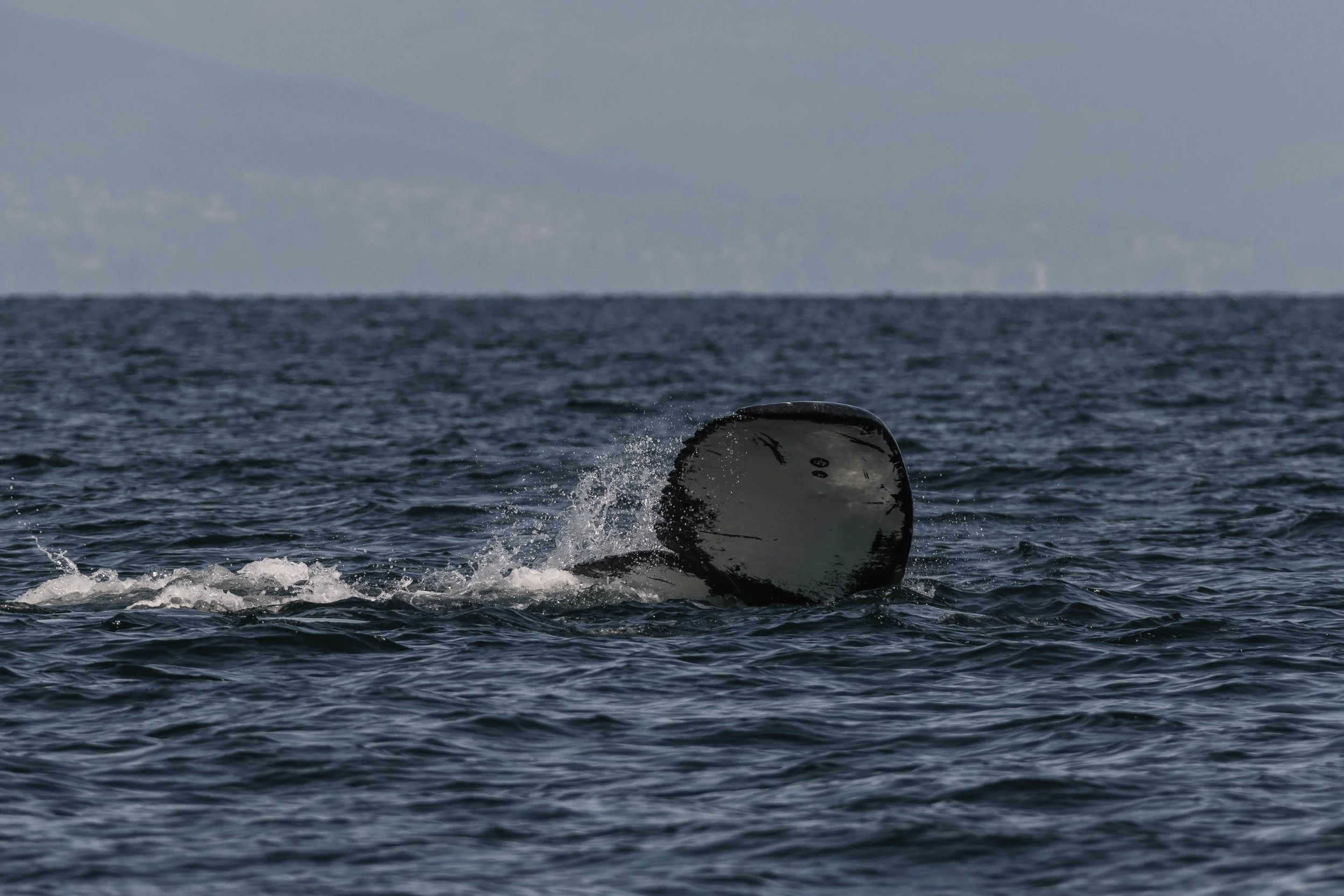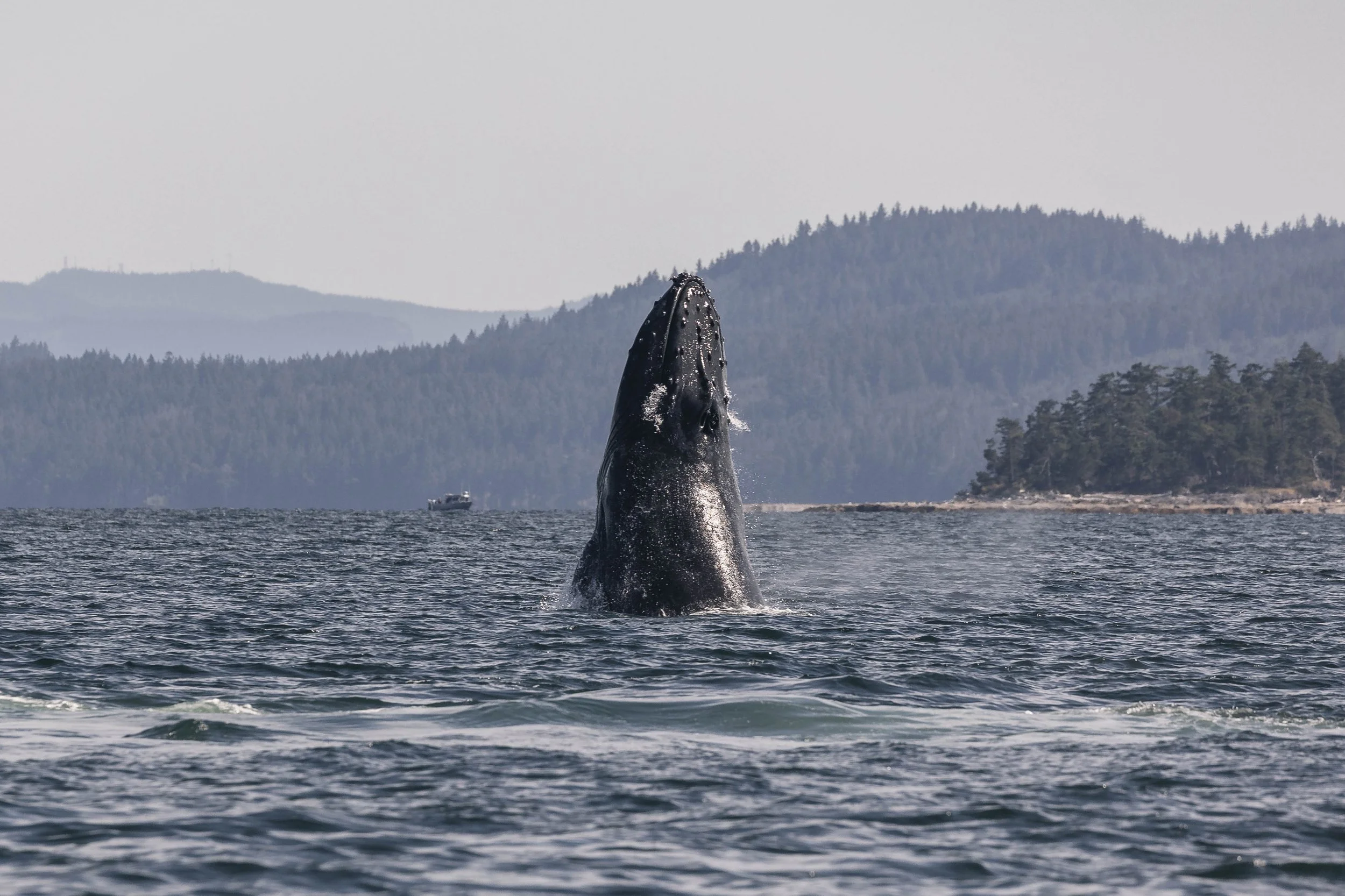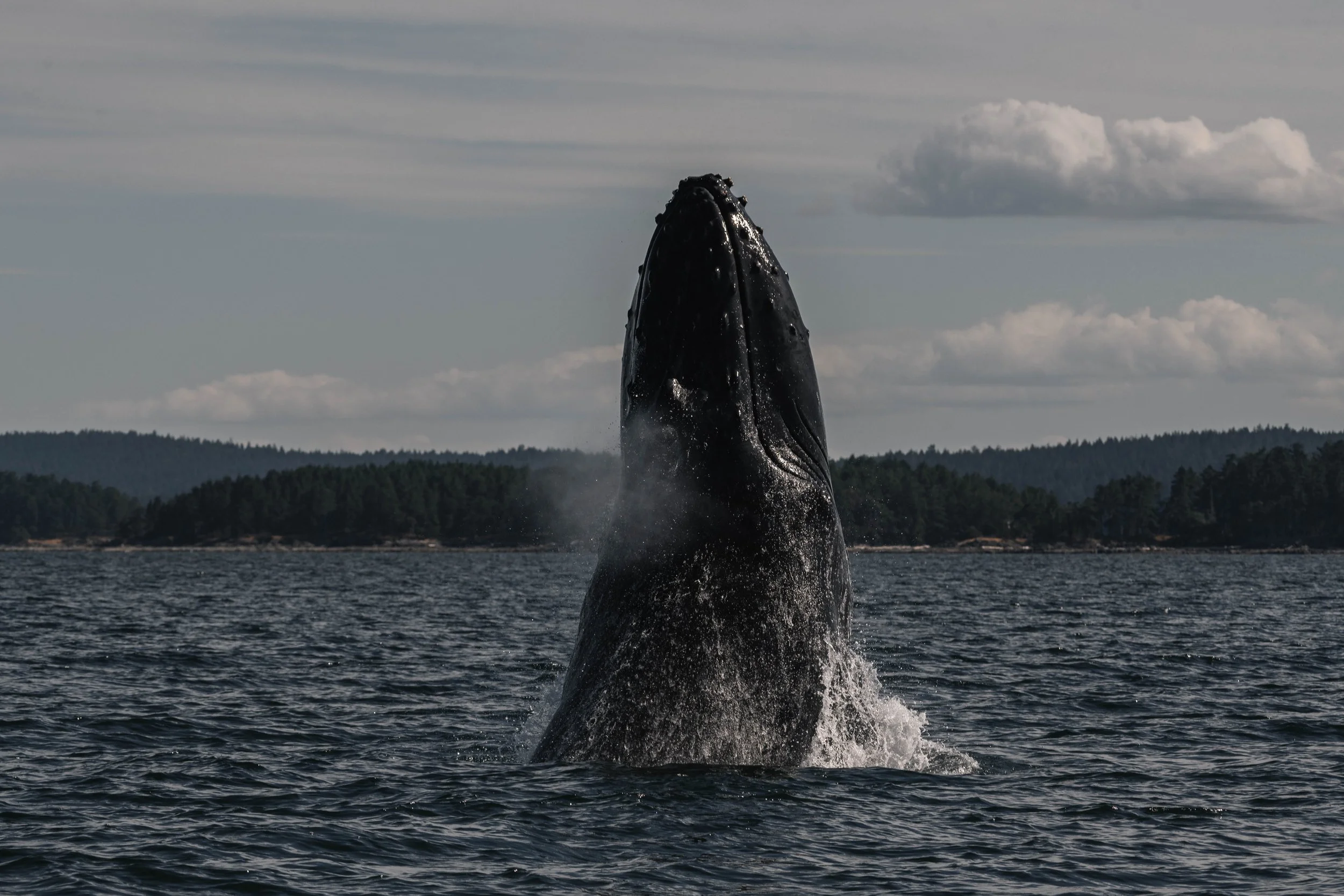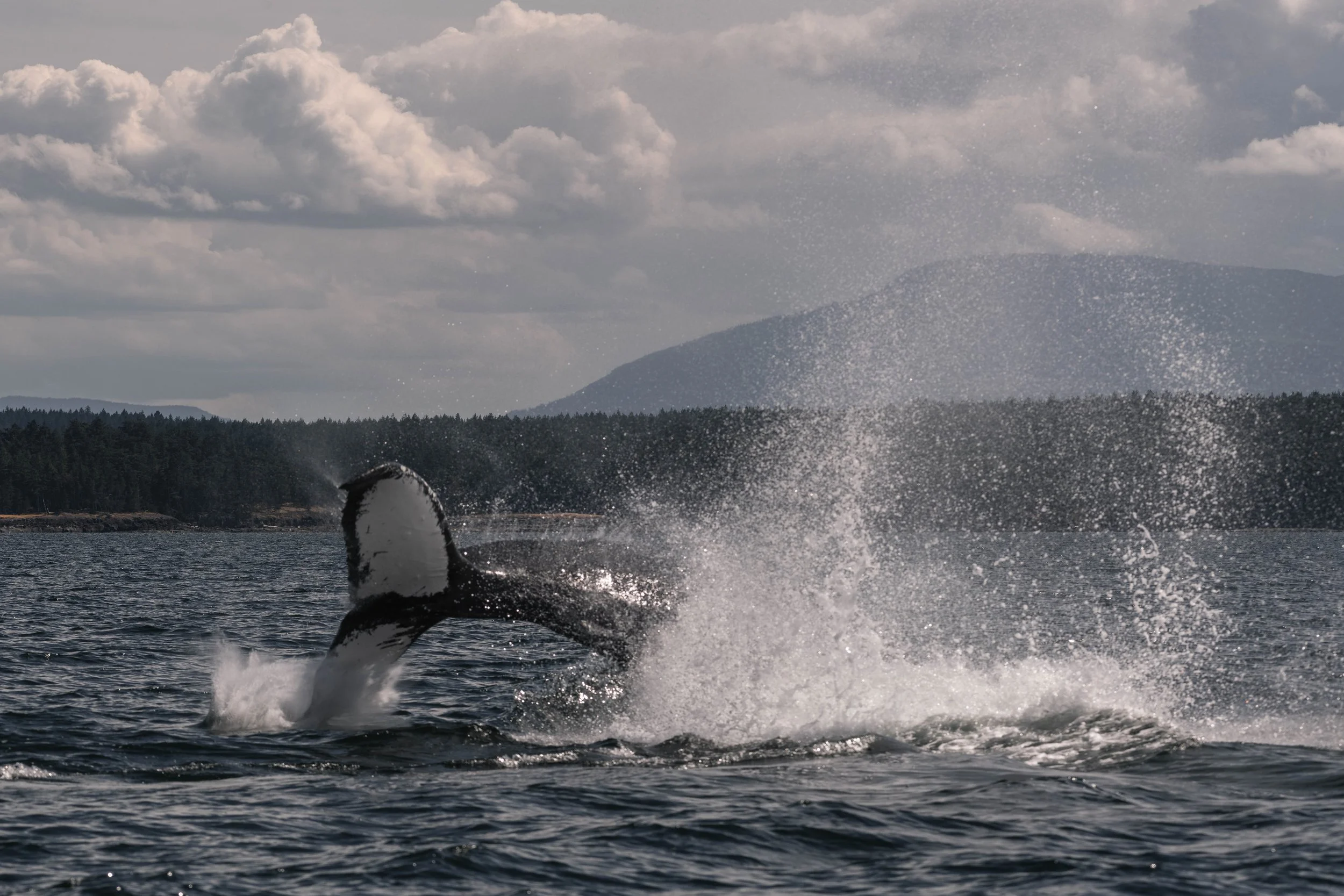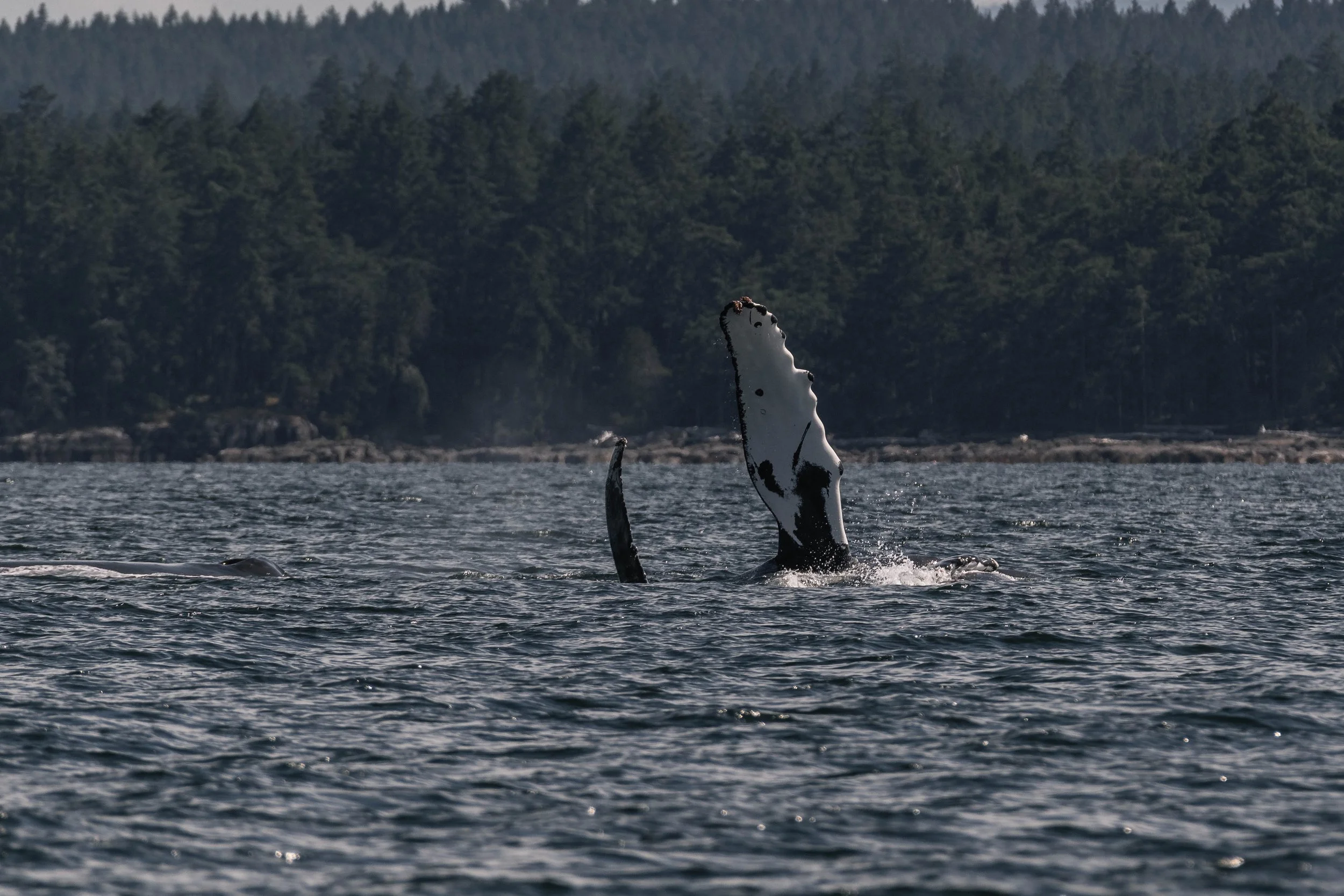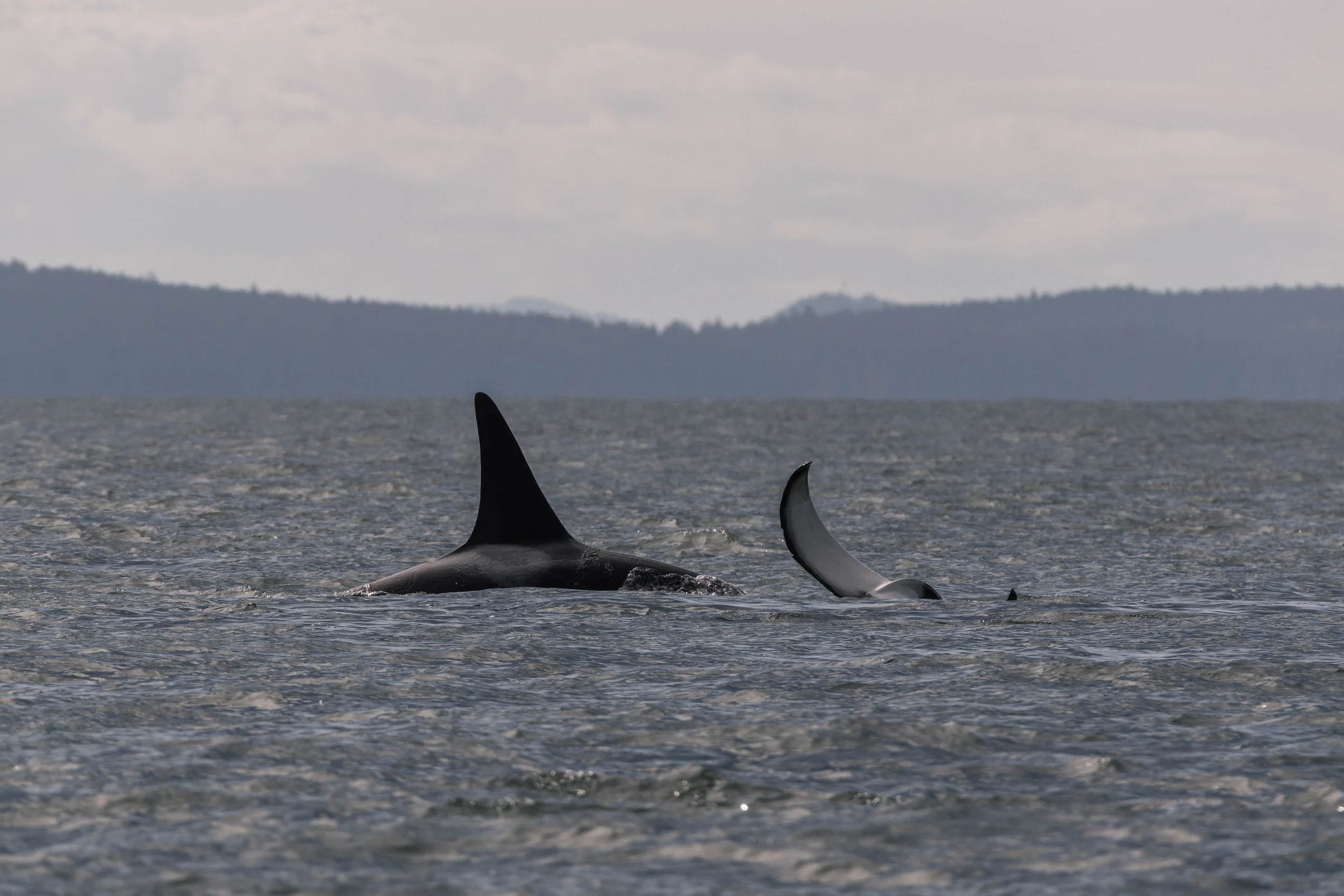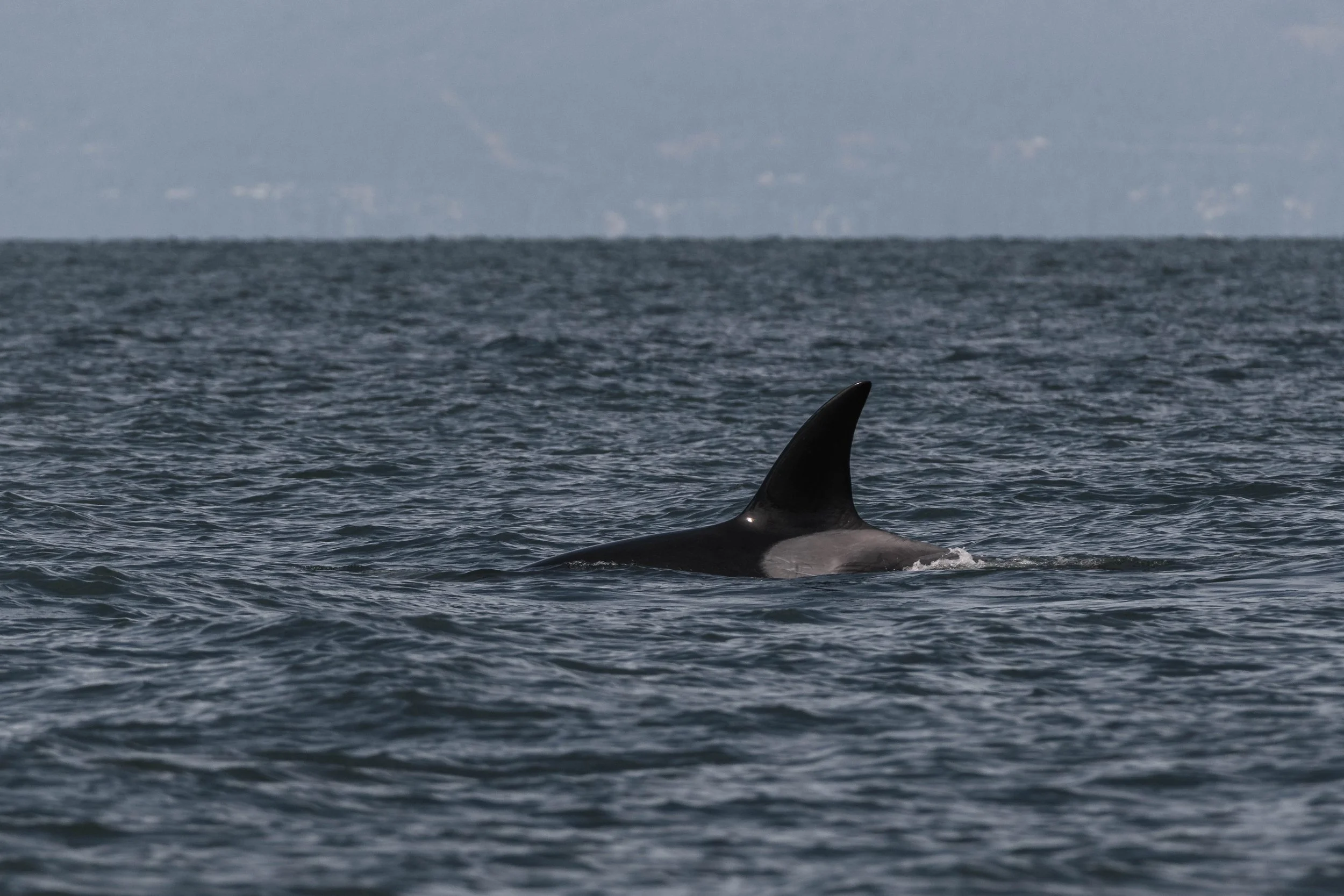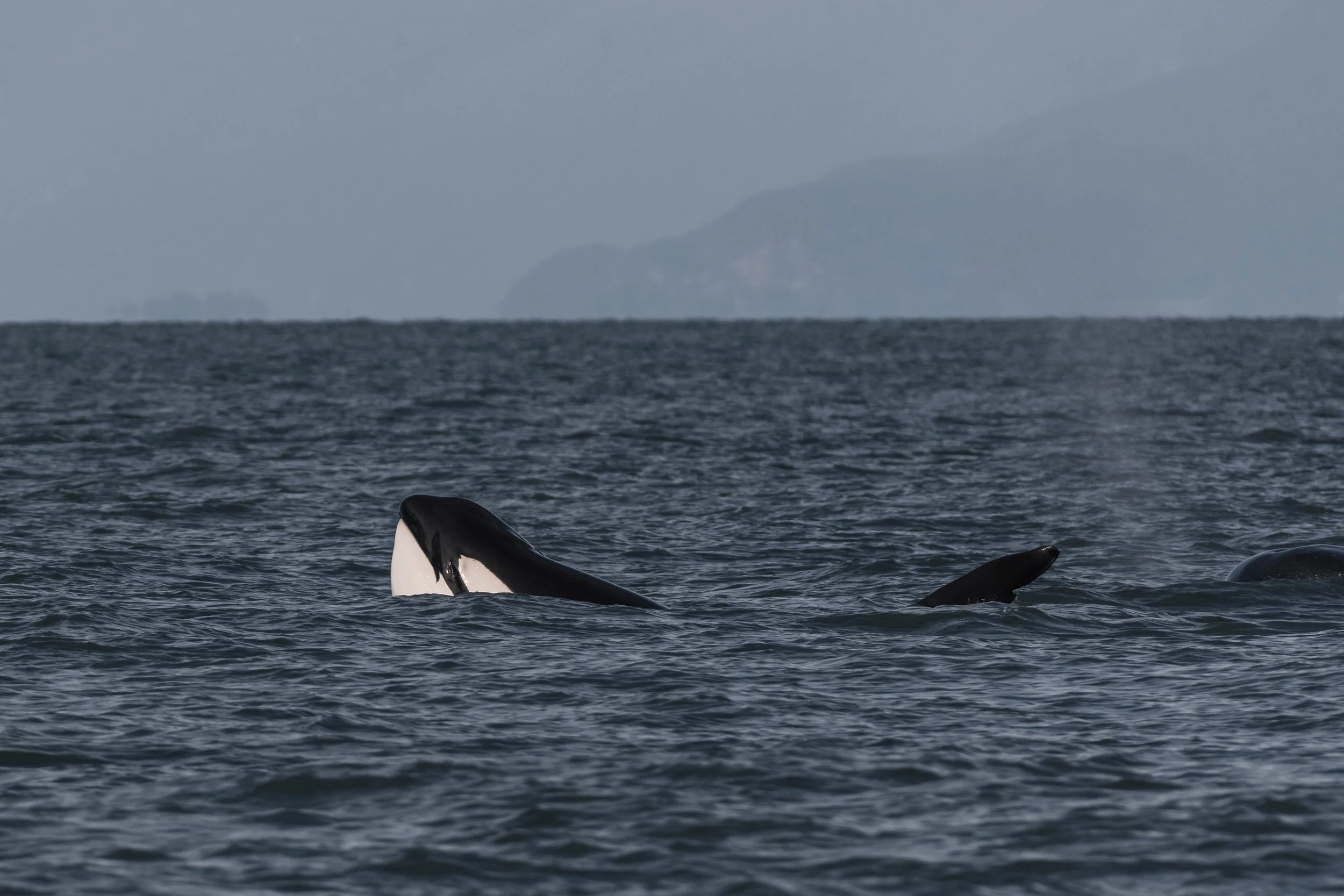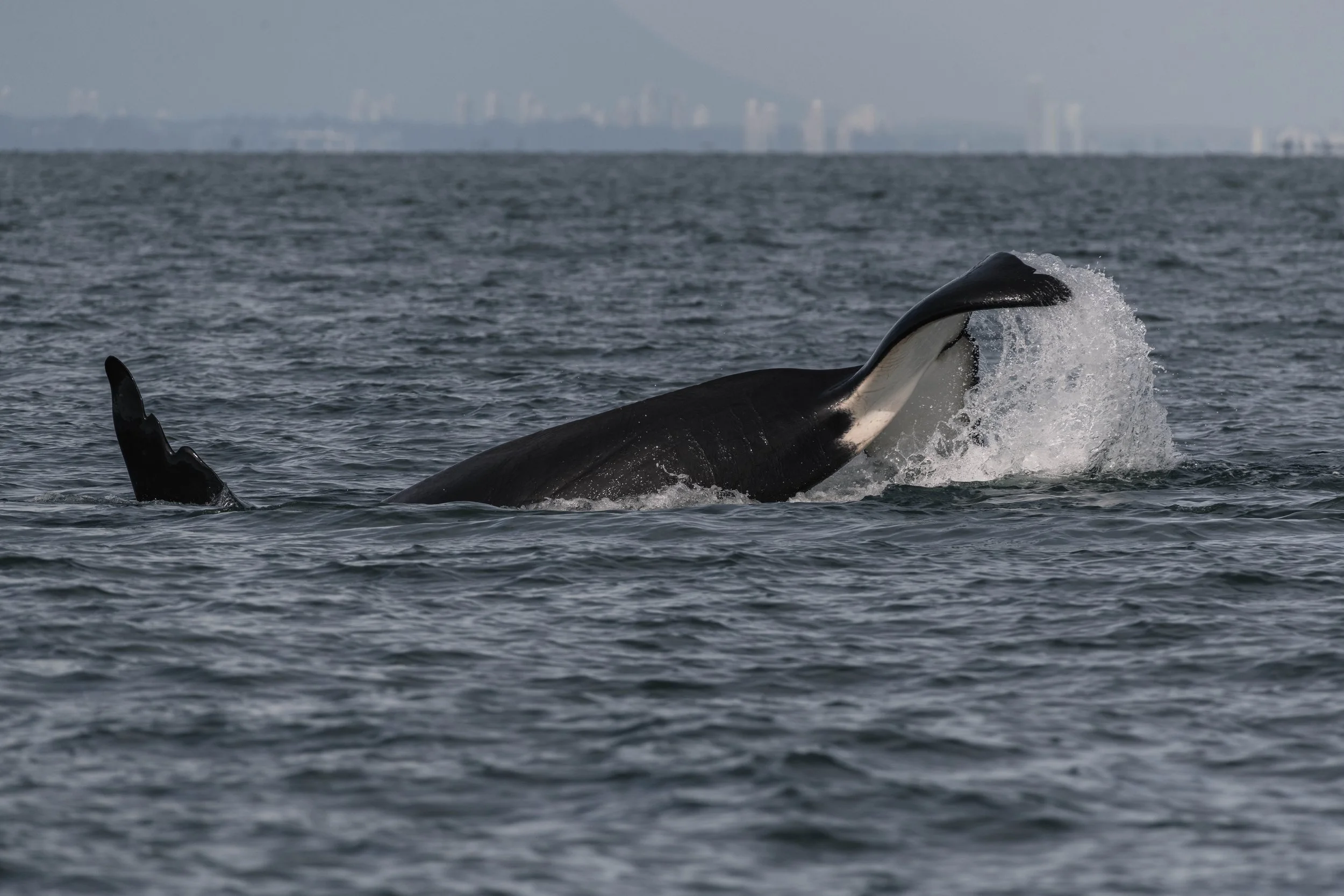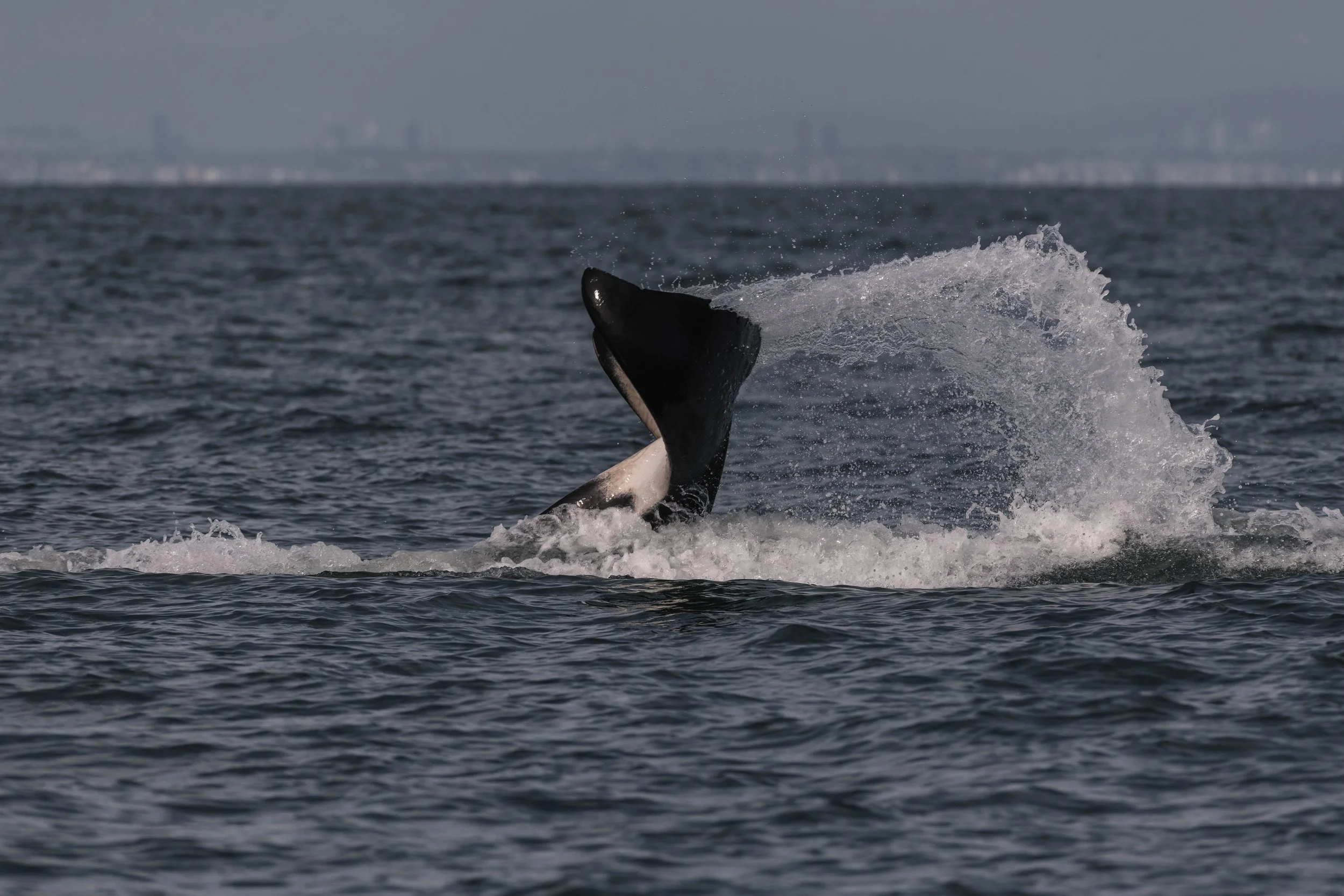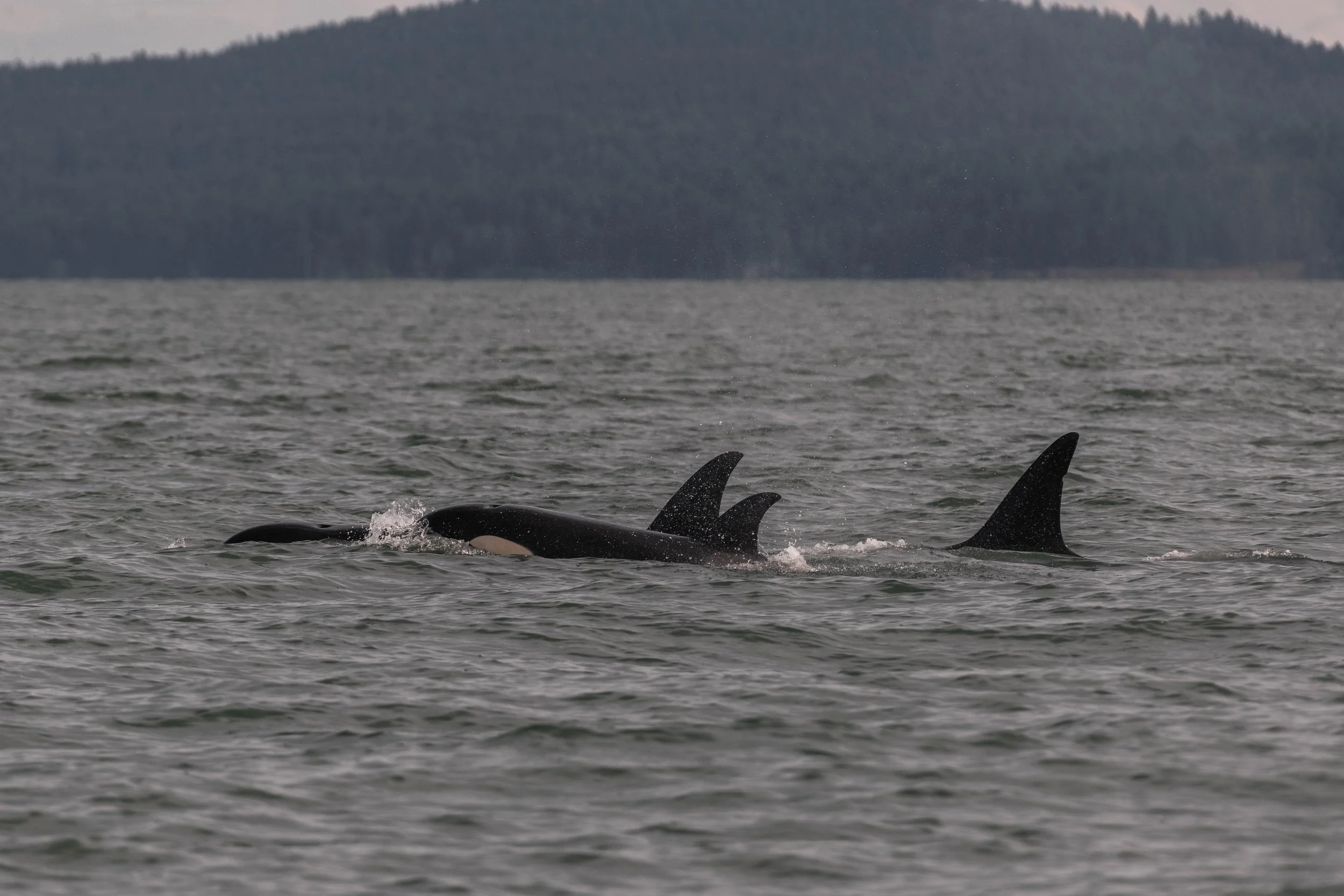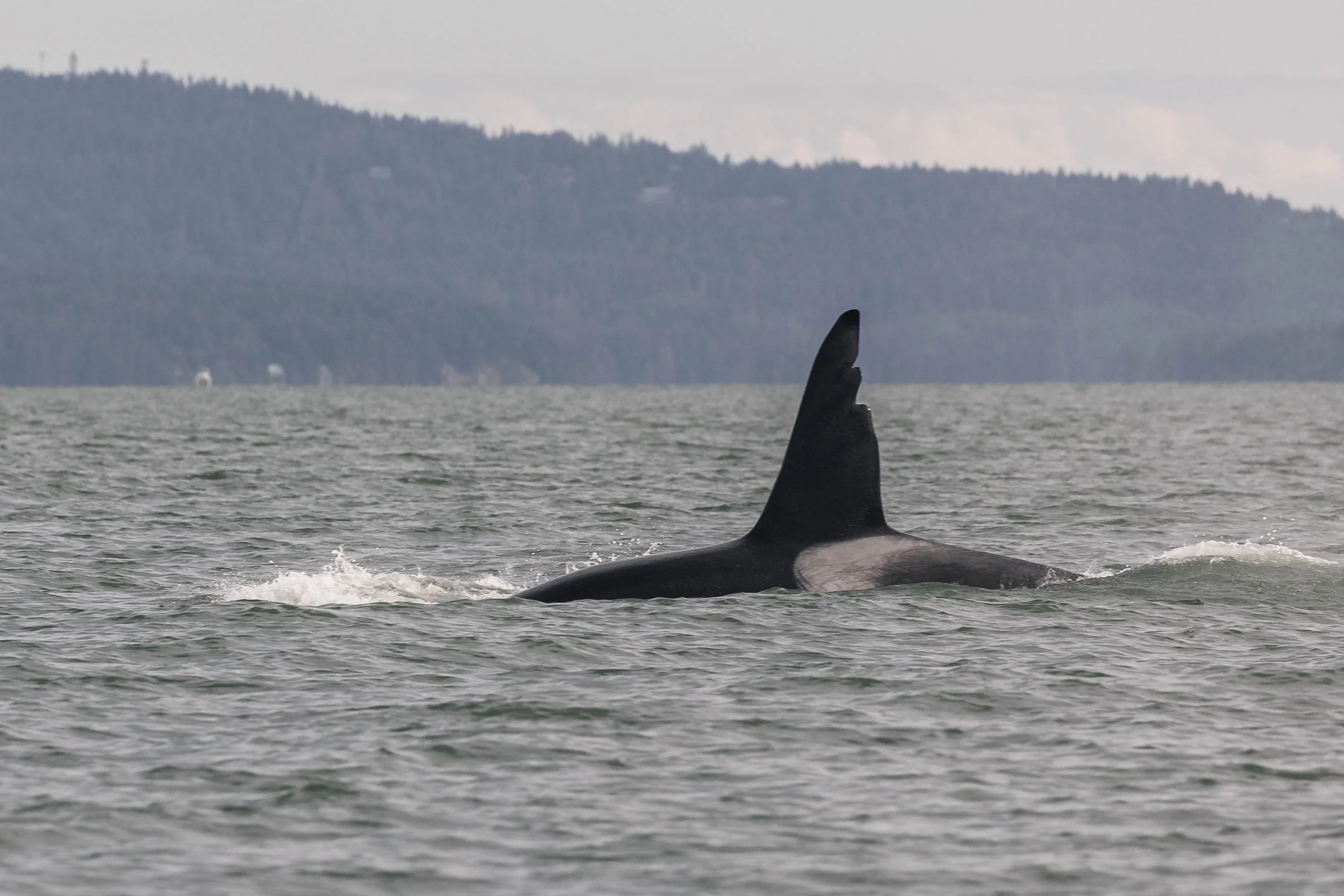July 3, 2025, 3:30 PM - Orca and Humpbacks out in the Strait
We had two vessels off the dock this afternoon, and we were excited to get back out there and see who we could find. We started our search in the Strait and came across some splashes in the distance. We travelled over to see what could be the cause! It was a trio of humpbacks up to something, we had a flurry of activity. We had Anvil (BCZ0410), Two Spot (BCZ0432), and Ocular (BCX1705).
Humpback whales are well known for their dramatic and expressive surface behaviours, and witnessing these massive animals in action is a highlight for any whale watcher. One of the most iconic displays is breaching, when a whale propels itself out of the water and crashes back down with an enormous splash. This behaviour is not only visually spectacular but also energetically costly. It takes an immense amount of strength and coordination to lift a 30–40-ton animal out of the water, and a single breach can burn hundreds of calories. Scientists believe breaching may serve multiple purposes, including communication, parasite removal, and even play.
Other common behaviours include chin slapping and tail slapping. During a chin slap, the whale lifts its head out of the water and slams its lower jaw onto the surface, possibly as a way to signal its presence or assert dominance. Tail slapping, or lobtailing, involves lifting the fluke high into the air and forcefully smacking it against the water, often repeatedly. This creates a loud sound that can be heard both above and below the surface, and may act as a warning, a call to other whales, or a way to stun fish during feeding.
Cartwheeling is another playful and energetic behaviour, where a humpback throws one of its massive pectoral fins out of the water while rotating its body, often resembling a slow-motion somersault. Like breaching, this move demands a huge expenditure of energy. Humpbacks build up these energy reserves by feeding on thousands of pounds of small fish and krill during the summer months. Every movement requires careful budgeting of these calories, especially for whales preparing for long migrations to warmer breeding grounds, where they often fast for months.
Amidst all this activity, humpbacks are also known to rest. They don’t sleep in the same way we do, instead, they shut down one hemisphere of their brain at a time, allowing them to surface and breathe while staying partially alert. Resting can happen at the surface, where they float motionless (sometimes called “logging”), or slowly cruise just beneath the waterline. These moments of calm are vital, allowing humpbacks to recharge and conserve energy between feeding or displaying social behaviours. Whether they're leaping into the air or quietly drifting along, every action we witness on the surface tells part of the story of their complex and fascinating lives. After witnessing so much activity and getting a glimpse into the life of a humpback, including seeing them take a nap, we left them to rest and continued searching the Strait.
After scanning the waves, we spotted something else…this time it was a big black dorsal fin! We had orca! Not just one, it appears we had stumbled upon a T-party! The orca present were:
T046B Raksha ♀ (1988)
T046B2 Akela ♀ (2008)
T046B3 Sedna ♀ (2011)
T046B4 Quiver ♀ (2013)
T046B6 Sol ♀ (2019)
T046B7 (2023)
T065 Whidbey II ♀ (~1971)
T063 Chainsaw ♂ (~1978)
T065B Chunk ♀ (1993)
T065B1 Birdsall ♂ (2011)
T065B2 Nettle ♂ (2019)
T065B3 Rook ♂ (2023)
Every so often, our transient orca, also known as Bigg’s killer whales, come together in what we affectionately call a "T-party." These gatherings are an extraordinary sight, as typically small, stealthy family groups join forces, socializing in numbers we don’t often see. Transient orca are usually found travelling in matrilineal pods of just 2–8 individuals, quietly hunting marine mammals like harbour seals, sea lions, and porpoises. So when multiple pods meet up in one area, the energy shifts. The ocean feels suddenly electric.
These gatherings can include 10, 20, even 30 or more individuals, representing several different families. When this happens, we have a chance to see an increased surface activity, tail slaps, spyhops, breaching, and vocalizations, all signs of excitement and communication. These T-parties seem to serve a few purposes. They give the whales a chance to reinforce social bonds, especially between related pods. They may also offer younger whales a chance to play and socialize with others outside their immediate family. And in some cases, males may use these meetings as opportunities to display themselves to receptive females from other groups.
Because transient orca are apex predators with strong social structures, these parties are crucial for maintaining relationships within their broader community. Each T-party is unique, sometimes lasting a few hours, other times stretching across multiple days, with pods splitting off and rejoining. For us on the water, it’s a privilege to witness. These rare meet-ups remind us how intelligent, adaptable, and socially complex these animals truly are. After partying with the orca we decided to start making our way back home, but there was one more BIG surprise!
It was Big Mama (BCY0324) and her new calf, calf of BCY0324 Big Mama 2025! Big Mama holds a special place in our hearts. She was the very first humpback whale to return to the Salish Sea after the whaling era, making her a symbol of resilience and hope. First documented here in 1997, she marked the beginning of a remarkable comeback for humpbacks in these waters. Her return signalled that the Salish Sea was once again becoming a safe and thriving habitat for these giants of the deep.
This year, Big Mama surprised and delighted us with a brand new calf by her side, her eighth known offspring. Watching her guide and nurture her young one through these coastal waters is nothing short of awe-inspiring. Her calves are a living legacy, a testament to the rebounding population and the importance of protecting these feeding grounds.
Seeing Big Mama, a true pioneer of the post-whaling era, now teaching the next generation how to navigate this ecosystem, reminds us how far we’ve come and how vital it is to continue safeguarding their future. After spending time with our celebrity whale and her new bundle of joy, it was time for us to head home with the soft light of the setting sun welcoming us back to Nanaimo.
Enjoy the photos below taken by Marine Naturalists Aly Kohlman and Hayleigh Hilbert.
Ocular’s dorsal fin. Photo Aly Kohlman.
Two Spot going down. Photo Aly Kohlman.
Check out all those barnacles on these pecs. Photo Aly Kohlman.
Two Spot’s dorsal with Anvil fluking beside. Photo by Hayleigh Hilbert.
Ocular. Photo Aly Kohlman.
Ocular flicking their tail! Photo Aly Kohlman.
Breach for the sky. Photo Aly Kohlman.
Another breach! Photo by Hayleigh Hilbert.
Going up! Photo Aly Kohlman.
Can you spot both humpbacks in this photo. Photo Aly Kohlman.
Anvil with a cartwheel. Photo Aly Kohlman.
Pec slap! Photo by Hayleigh Hilbert.
These pecs can be 16 to 18 feet long. Photo Aly Kohlman.
Pecs in the air. Photo Aly Kohlman.
T065B1 Birdsall with T065 Chainsaw’s tail. Photo Aly Kohlman.
T063 Chainsaw. Photo Aly Kohlman.
T063 Whidbey ll with a spy-hop. Photo Aly Kohlman.
T046B4 Quiver. Photo Aly Kohlman.
T063 Whidbey ll with T065 Chainsaw surfacing behind. Photo Aly Kohlman.
T063 Chainsaw with T065B1 Birdsall getting excited. Photo Aly Kohlman.
T065B1 Birdsall with T065 Chainsaw coming up beside him. Photo Aly Kohlman.
T065B1 Birdsall with T065 Chainsaw following. Photo Aly Kohlman.
T065 Chainsaw. Photo Aly Kohlman.
T065B1 Birdsall. Photo Aly Kohlman.
Tail flick! Photo Aly Kohlman.
T065 Chainsaw. Photo Aly Kohlman.
T046B4 Quiver coming up beside T065B1 Birdsall. Photo Aly Kohlman.
Can you see how orange T046B7’s eye patch is? Photo Aly Kohlman.
T046B Raksha with T046B6 Sol behind her and T046B2 Akela behind them. Photo Aly Kohlman.
T046B3 Sedna with one of the calves in tow. Photo Aly Kohlman.
T046B2 Akela with T046B2B beside her with T046B Raksha surfacing behind. Photo Aly Kohlman.
The T-party in full force! Photo Aly Kohlman.
T065B1 Birdsall with T065 Chainsaw followig as another surfaces between. Photo by Hayleigh Hilbert.
T065B1 Birdsall. Photo by Hayleigh Hilbert.
T065B1 Birdsall crashing through the waves. Photo by Hayleigh Hilbert.
T063 Chainsaw’s turn to pick up speed. Photo by Hayleigh Hilbert.
T063 Chainsaw. Photo by Hayleigh Hilbert.
T065B1 Birdsall. Photo by Hayleigh Hilbert.
Big Momma. Photo Aly Kohlman.
Big Momma’s newest calf! Photo Aly Kohlman.

